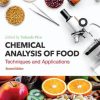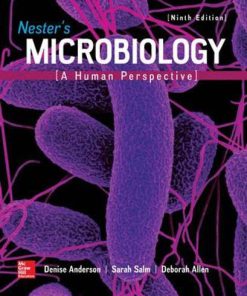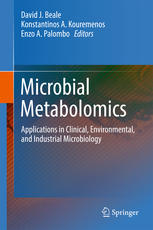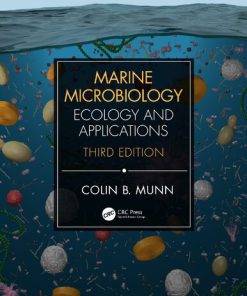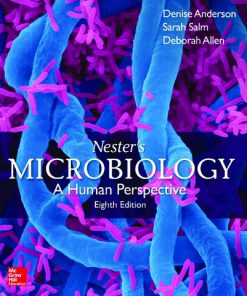Quantitative Microbiology In Food Processing Modeling The Microbial Ecology 1st edition by Anderson De Souza Sant’Ana 1118823052 9781118823057
$50.00 Original price was: $50.00.$25.00Current price is: $25.00.
Quantitative Microbiology In Food Processing: Modeling The Microbial Ecology 1st edition by Anderson De Souza Sant’Ana – Ebook PDF Instant Download/DeliveryISBN: 1118823052, 9781118823057
Full download Quantitative Microbiology In Food Processing: Modeling The Microbial Ecology 1st edition after payment.
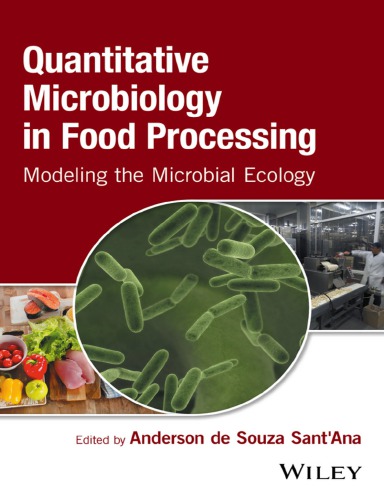
Product details:
ISBN-10 : 1118823052
ISBN-13 : 9781118823057
Author: Anderson De Souza Sant’Ana
Microorganisms are essential for the production of many foods, including cheese, yoghurt, and bread, but they can also cause spoilage and diseases. Quantitative Microbiology of Food Processing: Modeling the Microbial Ecology explores the effects of food processing techniques on these microorganisms, the microbial ecology of food, and the surrounding issues concerning contemporary food safety and stability. Whilst literature has been written on these separate topics, this book seamlessly integrates all these concepts in a unique and comprehensive guide. Each chapter includes background information regarding a specific unit operation, discussion of quantitative aspects, and examples of food processes in which the unit operation plays a major role in microbial safety. This is the perfect text for those seeking to understand the quantitative effects of unit operations and beyond on the fate of foodborne microorganisms in different foods. Quantitative Microbiology of Food Processing is an invaluable resource for students, scientists, and professionals of both food engineering and food microbiology.
Quantitative Microbiology In Food Processing: Modeling The Microbial Ecology 1st Table of contents:
PART I: Introductory section
CHAPTER 1: Introduction to the microbial ecology of foods
1.1 Introduction
1.2 Role of food characteristics and environment on microbial fate
1.3 Understanding microbial growth, death, persistence, competition, antagonism and survival in food
1.4 Methods to study the microbial ecology of foods
1.5 Perspectives on applying food ecosystem modeling
References
CHAPTER 2: Predictive microbiology: mathematics towards understanding the fate of food-borne microorganisms in food processing
2.1 Introduction
2.2 Probability and kinetic models for food processing and HACCP
2.3 Thermal inactivation
2.4 Non-thermal inactivation and modeling stress-adaptation strategies
2.5 Fermentation: a dynamic environment for microbial growth and pathogen inactivation
2.6 Colonial versus planktonic type of growth: modes of microbial existence on surfaces and in liquid, semi-liquid, and solid foods
2.7 Modeling microbial transfer between processing equipment and foods
2.8 Alternative multivariate approaches: the use of bioinformatics for characterizing spoilage and product classification
References
CHAPTER 3: Principles of unit operations in food processing
3.1 Introduction
3.2 Principles of transport phenomena
3.3 Principles and unit operations of momentum transfer
3.4 Principles and unit operations of heat transfer
3.5 Principles and unit operations of mass transfer
3.6 Conclusions
References
PART II: Impact of unit operations on microorganisms of relevance in foods
CHAPTER 4: Impact of materials handling at pre- and post-harvest operations on the microbial ecology of foods of vegetable origin
4.1 Introduction
4.2 The production environment
4.3 Soil
4.4 Fertilizers derived from animal wastes
4.5 Irrigation
4.6 Harvesting and handling
4.7 Postharvest processing
4.8 Packaging, storage, and transportation
4.9 Conclusions
References
CHAPTER 5: Impact of heating operations on the microbial ecology of foods
5.1 Background and basic information of heating operations
5.2 Quantitative aspects and how unit operations impact on food-borne microorganisms
5.3 Application of F-value concept
5.4 Dealing with non-linearity
5.5 Development of new concepts to assess heat processes
5.6 Microbial safety and stability of heating operations: challenges and perspectives
References
CHAPTER 6: Impact of refrigeration operations on the microbial ecology of foods
6.1 Introduction
6.2 Refrigeration as a unit operation
6.3 Dynamic effect of chilling on growth of C. perfringens during cooling
References
CHAPTER 7: Impact of dehydration and drying operations on the microbial ecology of foods
7.1 Introduction
7.2 Modeling the drying process in food
7.3 Modeling microbial survival/inactivation in drying/dehydration processes
7.4 Example of application/development of predictive microbiology models for describing microbial death during drying processes
7.5 Conclusions
References
CHAPTER 8: Impact of irradiation on the microbial ecology of foods
8.1 Introduction
8.2 Ionizing radiation
8.3 Non-ionizing radiation
References
CHAPTER 9: Impact of high-pressure processing on the microbial ecology of foods
9.1 Introduction
9.2 Processing operation
9.3 Bacteria and enzyme inactivation
9.4 Effect of high pressure on fruit and vegetable products
9.5 Effect of HHP on meat and other food products
9.6 Effect of added antimicrobial on pathogen inactivation by high-pressure processing (hurdle approach)
9.7 High-pressure carbon dioxide (HPCD) disinfection
9.8 Effect of HHP on bacteria, virus, insects, and other organisms
9.9 Effect of HHP on quality: color, flavor, texture, sugar, totally soluble, and insolubles
9.10 Advantages and disadvantages of using HHP
9.11 Applications and conclusions
References
CHAPTER 10: Impact of Vacuum packaging, modified and controlled atmosphere on the microbial ecology of foods
10.1 Introduction
10.2 Vacuum packaging
10.3 Controlled atmosphere
10.4 Modified atmosphere packaging
References
CHAPTER 11: Impact of fermentation on the microbial ecology of foods
11.1 Introduction
11.2 Fermentations: microbial ecology and activity
11.3 Factors affecting food-borne pathogen inactivation during fermentation
11.4 Challenge tests
11.5 Predictive modeling
11.6 Conclusions
References
CHAPTER 12: Impact of forming and mixing operations on the microbial ecology of foods: focus on pathogenic microorganisms
12.1 Forming
12.2 Homogenizing
12.3 Mixing
References
CHAPTER 13: Impact of specific unit operations on food-borne microorganisms: curing, salting, extrusion, puffing, encapsulation, absorption, extraction, distillation, and crystallization
13.1 Introductory remarks
13.2 Burden of food-borne illnesses
13.3 Food safety and food quality
13.4 Prevention and control through processing
13.5 Conclusions and prospects for the future
References
CHAPTER 14: Impact of food unit operations on virus loads in foods
14.1 Introduction
14.2 The use of surrogate viruses to assess inactivation processes
14.3 Virus contamination in food processing
14.4 Survival of virus in the food processing chain
14.5 Effect of food preservation techniques on the virus load
14.6 Conclusion and perspectives
References
CHAPTER 15: Impact of food unit operations on parasites in foods: focus on selected parasites within the fresh produce industry
15.1 Background and introduction
15.2 Detection of selected parasites in fresh produce
15.3 Effects of fresh produce treatments on selected parasites
15.4 Conclusion
References
CHAPTER 16: Impact of food unit operations on probiotic microorganisms
16.1 Introduction
16.2 Probiotic products
16.3 probiotics and environmental stress: cellular mechanisms and resistance
16.4 Enhancing stress resistance of probiotics
16.5 Conclusion
References
PART III: Microbial ecology of food products
CHAPTER 17: Microbial ecology of fresh vegetables
17.1 Introduction
17.2 Prevalence and diversity of microbial communities on fresh vegetables (post-harvest)
17.3 Post-harvest persistence, colonization, and survival on fresh vegetables
17.4 Routes of contamination during post-harvest handling of fresh and fresh-cut vegetables
17.5 Microbial adaptation on produce commodity
17.6 Effective post-harvest intervention technologies
References
CHAPTER 18: Microbial ecology of fruits and fruit-based products
18.1 Introduction
18.2 Fresh whole fruits
18.3 Minimally processed fruits
18.4 Processed fruits
Acknowledgments
References
CHAPTER 19: Microbial ecology of cereal and cereal-based foods
19.1 Introduction
19.2 Sourdough
19.3 Ethnic fermented foods
19.4 Spoilage of cereals and cereal products
References
CHAPTER 20: Microbial ecology of nuts, seeds, and sprouts
20.1 Introduction
20.2 Definition and classification of nuts, seeds, and sprouts
20.3 Microbial ecology of nuts and seeds
20.4 Microbial ecology of sprouts and their corresponding seeds
20.5 Implications and perspectives
References
CHAPTER 21: Microbial ecology of eggs: a focus on Salmonella and microbial contamination in post-harvest table shell egg production
21.1 Introduction
21.2 Historical and current trends in commercial egg production
21.3 Egg production management on the farm and incidence of Salmonella
21.4 Egg processing and microbial contamination: general aspects
21.5 Microbial contamination during egg collection at the farm to in-line processing
21.6 Microbial contamination during transportation to off-line egg processing facilities
21.7 Microbial contamination during egg processing
21.8 Egg washwater and sanitation
21.9 Egg retail and microbial contamination
21.10 Conclusions and future directions
Acknowledgment
References
CHAPTER 22: Microbial ecology of beef carcasses and beef products
22.1 Introduction
22.2 Carcass production process
22.3 Carcass breaking
References
CHAPTER 23: Microbial ecology of pork meat and pork products
23.1 Introduction
23.2 Pork meat as a substrate for microbial growth: chemical and physical characteristics
23.3 Microbial ecology of fresh pork meat: sources of contamination and microbial groups
23.4 Microbial ecology of chilled pork meat
23.5 Microbial ecology of vacuum/modified atmosphere packaged pork meat
23.6 Microbial ecology of marinated pork meat
23.7 Microbial ecology of cured and fermented/ripened pork meats
23.8 Microbial ecology of high-pressure preserved pork meat
References
CHAPTER 24: Microbial ecology of poultry and poultry products
24.1 Introduction
24.2 Microbial hazard identification and prioritization
24.3 Microbial aspects of poultry processing at abattoirs
24.4 Microbial aspects of derived poultry meat products
References
CHAPTER 25: Microbial ecology of seafoods: a special emphasis on the spoilage microbiota of North Sea seafood
25.1 Introduction
25.2 Total viable counts (TVC s) and microorganisms identified depends on the method used
25.3 The initial microbiota of marine fish
25.4 Raw seafood
25.5 Processing – lightly preserved seafood
25.6 A case study: brown shrimp (Crangon crangon) (adapted from Broekaert et al., 2013)
References
CHAPTER 26: Microbial ecology of mayonnaise, margarine, and sauces
26.1 Introduction
26.2 Mayonnaise
26.3 Margarine
26.4 Sauces and salad dressings
26.5 Conclusion
References
CHAPTER 27: Microbial ecology of confectionary products, honey, sugar, and syrups
27.1 Introduction
27.2 Cocoa and chocolate
27.3 Nuts and peanut butter
27.4 Honey
27.5 Sugar
27.6 Syrups
27.7 Conclusion
References
CHAPTER 28: Microbial ecology of wine
28.1 Introduction
28.2 Biodiversity of grape microorganisms
28.3 Microorganism ecology in winemaking
28.4 Microorganism ecology during aging
28.5 Microbial identification by classical methods
28.6 Microbial identification by molecular methods
References
CHAPTER 29: Microbial diversity and ecology of bottled water
29.1 Definitions of bottled water
29.2 Characteristics of mineral and spring water
29.3 Useful methods to study bottled water microbiota
29.4 Microbiological diversity
29.5 Bottling effect
29.6 Microbiological contamination
29.7 A new perspective on microbiological quality and safety
Acknowledgments
References
PART IV: Closing section
CHAPTER 30: Microbial risk assessment: integrating and quantifying the impacts of food processing operations on food safety
30.1 Introduction
30.2 Basic processes encountered during food processing operations
30.3 Risk-based objectives for each processing operation
30.4 Conclusion
References
CHAPTER 31: Quorum sensing and microbial ecology of foods
31.1 Introduction
31.2 Quorum sensing and microbial behavior
31.3 Quorum sensing and food ecology
31.4 Quorum quenching
References
CHAPTER 32: Heterogeneity in Bacillus subtilis spore germination and outgrowth: an area of key challenges for “omics” in food microbiology
32.1 Bacterial spores in the food industry
32.2 The Bacillus genus
32.3 Sporulation cycle
32.4 Endospore structure and its resistance
32.5 Spore germination and outgrowth
32.6 Heterogeneity in bacterial (spore) physiology during germination and outgrowth
32.7 Steps towards single-cell physiology and “omics” measurements
References
CHAPTER 33: Role of stress response on microbial ecology of foods and its impact on the fate of food’borne microorganisms
33.1 Introduction
33.2 Acquisition of permanent stress tolerance through adaptive mutagenesis
33.3 Transient adaptive responses to stress: modulation of membrane fluidity as an example
33.4 Using food components to survive under harsh conditions
33.5 The balance between self-preservation and nutritional competence (SPANC)
33.6 Conclusions and future prospects
People also search for Quantitative Microbiology In Food Processing: Modeling The Microbial Ecology 1st:
qualitative vs quantitative microbiology
qualitative and quantitative microbiology
semi quantitative microbiology
2025 quantitative microbiology symposium
quantitative microbiology symposium
Tags: Quantitative, Microbiology, Food Processing, Modeling, Microbial Ecology, Anderson De Souza Sant Ana
You may also like…
Science (General)
Tensor Calculus for Engineers and Physicists Emil De Souza Sánchez Filho
Biology and other natural sciences
Science (General)
Biology and other natural sciences
Marine Microbiology: Ecology & Applications Third Edition Colin B. Munn
Politics & Philosophy - Government & Politics
Biology and other natural sciences - Biotechnology
Microbial enzyme technology in food applications 1st Edition Ray
Biology and other natural sciences
Nester’s Microbiology: A Human Perspective 8th Edition Anderson


